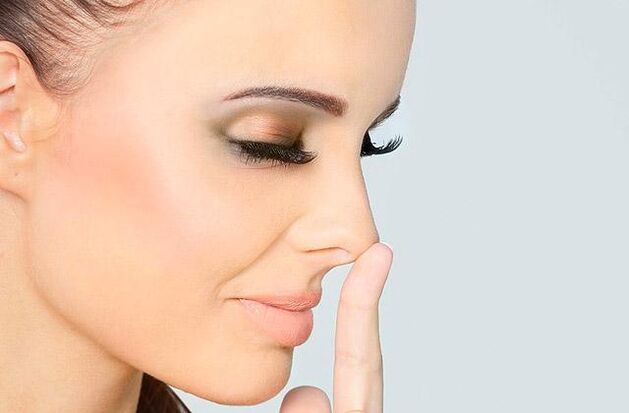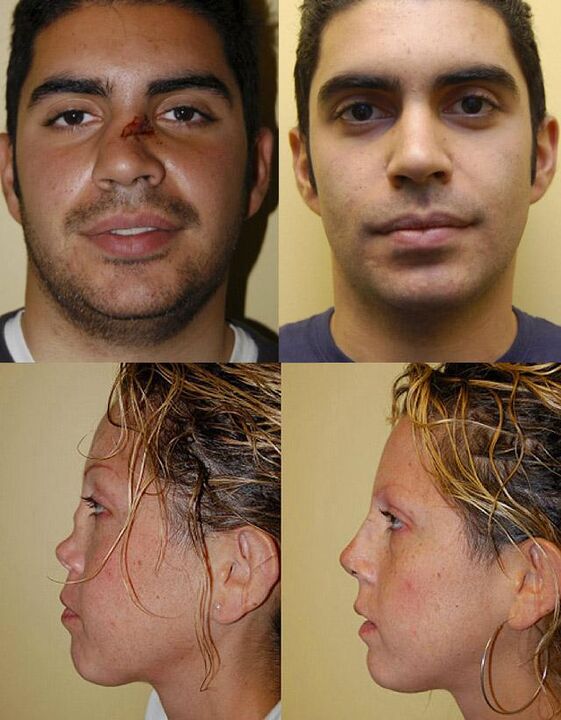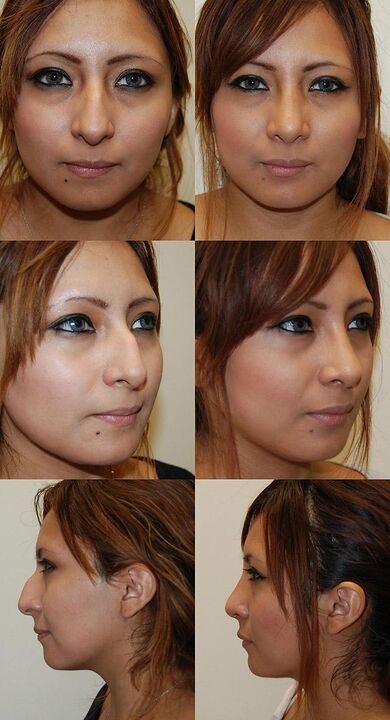
Rhinoplasty (nose plastic surgery) is the correction, restoration, correction of nasal structures using plastic surgery techniques. Used for medical and aesthetic reasons.
Despite its prevalence, nose correction surgeries are still considered one of the most difficult.
Nose repair surgeries have been performed for thousands of years. Ancient manuscripts testify to the successful experience of such procedures long before our era.
Medicine has come a long way compared to ancient physicians, and modern rhinoplasty is more of a cosmetic procedure than a medical necessity.
Indications for rhinoplasty
Any plastic surgery is a complex creative process that combines aesthetic problem-solving issues with the preservation or restoration of specific functional features of the organ (in this case, it is nasal breathing).
Thus, rhinoplasty can be performed for therapeutic and aesthetic purposes. The optimal age for performing it is 25-35 years old.
Medical indications are:
- congenital deformity of the nasal septum;
- polyps and turbine hypertrophy;
- traumatic injuries and post-traumatic changes in bone, cartilage, physiological (due to uneven tissue development) or compensatory curvature of the nasal septum;
- marked violation or complete lack of ability to breathe through the nose.
Changes in the exact anatomical structure of the nose are very often the cause of functional disorders and pathological conditions - shortness of breath, atrophy or hypertrophy of the nasal mucosa, rhinosinusitis, otitis media, frequent respiratory diseases, snoring at night.
In addition, in children, such defects can cause chronic oxygen starvation in the brain, which leads not only to their physical but also mental retardation and affects their mental development and behavioral responses. Therefore, rhinoplasty can also be performed on children under 18 years of age.
More than 60% of the reason for rhinoplasty is the patient’s desire to improve the shape of the nose to achieve complete harmony of his appearance. Plastic surgeon services are becoming more and more popular. Aesthetic indications for rhinoplasty are divided into two major groups:
- objective - these are disproportionate and unattractive nose sizes;
- subjective, or psychological: there are no specific criteria for evaluating beauty, each person has his own set stereotype, and therefore, simply for personal reasons, he may not like his nose.
These reasons often affect people's professional and personal relationships, create complexes of dissatisfaction and their inferiority, especially in the female environment, leads to poor social regulation.
Rhinoplasty for aesthetic purposes is indicated in cases when there are:
- disproportionate size of the nose in relation to the whole face - too large or, conversely, too small;
- congenital or acquired deformities;
- curvature of the nasal septum;
- enlarged nostrils, lumps;
- asymmetrical tip of the fork, lowered or very raised, as well as its inconsistency with the height of the back of the nose;
- saddle shape;
- aesthetically unsatisfactory result of previous surgery.
In many cases, the medical and aesthetic indications are the same and are the result of the same anatomical defects.

Types of rhinoplasty
In accordance with the purpose pursued and the technique of performing the surgical intervention, rhinoplasty is divided into:
- Reconstructor, whose purpose is to restore anatomical disorders resulting from improper intrauterine development, traumatic injuries, or disease.
- Aesthetics - correction of existing shortcomings.
According to the same criteria, there are several types of rhinoplasty:
- Reducing or enlarging the nose.
- Stretch support - correcting saddle depression or eliminating a lump.
- Correction of aesthetic imperfections of the tip.
- Septum correction (septoplasty).
- Post-traumatic reconstruction of the structure.
All types of operations are divided into:
- primary;
- secondary;
- repeated.
Entry techniques
When performing rhinoplasty, depending on the entry options, the following techniques are used:
- Closed rhinoplasty,in which incisions may occur in the nasal cavity. The closed entrance is divided into marginal (along the inner surfaces of the nasal wings), transseptal, inter- and transchondral. After cutting, the soft tissue separates (separates) from the cartilage and bones that make up the frame, allowing you to freely perform the necessary manipulations. Closed rhinoplasty is less traumatic than open rhinoplasty and eliminates arterial damage and tissue malnutrition, and postoperative scars are completely invisible as they are located in the nasal cavity. It is most often used, especially for aesthetic rhinoplasty.
- Open rhinoplasty- the incision passes along the columella (the part of the folding skin between the nostrils) and on the wings of the nose at their junction with the lip. The technique is used in cases that do not allow the task to be accomplished in another (closed) way. Allows you to lift soft tissues and cartilage upwards, to gain ample access to the inner parts of the nose and to perform manipulations under constant visual control. Open rhinoplasty is necessary to correct particularly serious changes and technically complex and important surgeries - pronounced deformity of the nose, especially with lateral displacement; combination of nasal deformity with malformations such as "lip cleft" or a hard palate crack; reconstruction using grafts. The disadvantage of open rhinoplasty is the formation of a visible postoperative scar, as well as the forced damage of the columella arteries, resulting in sensitive and long-term edema of the postoperative tissue.
Rhinoplasty of any type is performed under one of the types of general anesthesia and usually lasts for 1-2 hours. Sometimes their duration can reach three or more hours.
How is rhinoplasty performed?
The operation is performed in the following sequence:
- nasal septum correction is performed;
- if necessary, nasal shells are reduced;
- the nostril is corrected if it is necessary to form an equal profile;
- the bones split and shift to narrow the nasal pyramid;
- adjusts the nose;
- tip correction.
Revised rhinoplasty
Rhinoplasty of the nose is considered if there has already been a surgical intervention in this area. The final formation of the nose after plastic surgery occurs in six months - 1 year. This period is optimal for reoperation. It is performed when:
- the condition of the impossibility of achieving the goal at one stage;
- unsatisfactory results of the primary operation;
- the need to correct the problems that remain after primary rhinoplasty.
According to world statistics, 25-30% of patients who underwent primary rhinoplasty require a second corrective surgery. This is considered normal. It usually lasts no more than half an hour and is performed under local anesthesia. Corrective review rhinoplasty allows you to correct scarring imperfections and bring the shape of the nose to an aesthetic result that will satisfy the surgeon and the needs of the patient.
Repeatedly more difficult rhinoplasty is performed in cases of primary or unfavorable course performed poorly during the rehabilitation period, which often depends on the individual characteristics of the organism and complications. Such operations require a deeper examination and more thorough preparation. They represent a complete plastic according to one of the options, but, as a rule, they turn out to be much more complicated and more time consuming. Minor defects during repeated plastic surgery can lead to a final deterioration of the shape, not only, for example, of the tip, but also to a pronounced deformation of the entire nose.
Complications and preparation for surgery
Nasal plasticity is considered one of the most difficult plastic surgeries, the outcome of which depends largely on the skill and experience of the surgeon. Complications occur in 4-15% of cases. They can be during surgery (bleeding, skin rupture, rupture of the muco-cartilage flap, violation of the integrity of the bone pyramid, fracture of the bone surface, etc. ) and postoperative.
Possible complications after rhinoplasty:
- functional - atrophic rhinitis, difficulty breathing in the nose, loss of smell, temporary or permanent decrease or complete loss of sensitivity of the skin of the nose and upper lip;
- aesthetic - no change or deterioration of previous shortcomings;
- psychological dissatisfaction - the patient with the results of plastic surgery;
- infectious - prolonged swelling and inflammation, suppuration;
- pigmentation of the nasal skin, formation of a vascular, mucosal adhesions and rough wounds;
- recurrent nosebleeds and soft tissue or cartilage necrosis.
The preparation consists of:
- Consultation with a plastic surgeon, during which the technical possibilities of fulfilling the patient's wishes are determined.
- Conducting general studies - clinical and biochemical blood tests, blood clotting test (coagulogram), general urine analysis, tests for hepatitis, HIV, syphilis (RW), ECG.
- Conduct (if necessary) special studies - photographs of the paranasal sinuses, endoscopic examination of the nasal cavity in order to identify accompanying abnormalities and pathological changes.
- Computer simulation that allows the patient to compare the initial condition of the nose with the results of rhinoplasty in the future.
- Consultations of a therapist and specialized specialists (in the presence of chronic diseases).
- Examination by an anesthesiologist after all examinations.
- Refusal two weeks before surgery from taking drugs that affect blood clotting processes - acetylsalicylic acid and its analogues, anticoagulants.
- Stop taking sedatives and sleeping pills on the day of the intervention.
Contraindications and rehabilitation
Absolute contraindications for rhinoplasty:
- the presence of any chronic systemic disease in severe form (endocrine, cardiovascular, pulmonary);
- acute infectious diseases;
- blood clotting disorders;
- menstruation days.
Basic healing from rhinoplasty takes up to 3 weeks. However, the deadline for the full completion of the rehabilitation period, when the results are evaluated, is determined by the doctor and is 6-12 months. During this time, some restrictions must be observed.
After 1-1, 5 weeks after the intervention, the cast and sutures are removed. For the first two weeks, do not wash with hot water or take hot baths, as bleeding, bruising, and swelling may occur with the spread all over the face and neck. It is necessary to sleep only on the back in an elevated position, which helps facilitate breathing and reduce swelling. In dusty places, it is advisable to wear a face shield. Bending and lifting weights should be avoided.
Also, within 3 months, you should stop using glasses and wear tight or heavy hats. You can not visit the pool and sunbathe for 3 months. In hot and sunny weather, a wide-brimmed umbrella or hat is recommended.
When planning rhinoplasty options, an experienced surgeon adheres to the principles of three types of limitations: the limitations set by the surgeon himself; restrictions imposed by the patient; limitations associated with the patient's condition and the anatomical features of his nose.



PRICE
The cost of the operation depends on the complexity of the correction.
Witness
A woman review
"I have always had complexes because of the shape of my nose. It was very long, with a lump and the tip of my nose looked doubled. Last year I decided to have rhinoplasty. If I had done it earlier, then my life would have"It was now. Maybe better. They removed all the imperfections. They even restored the septum, the defect of which I did not even know. My nose is perfect, just like me. "
A man review
"After I broke my nose a few times, the nasal septum moved. I could not breathe normally, I snored heavily at night. The diagnosis showed temporary holding of breath in my sleep. The nose looked ugly, it had shifted to one side. I have to dorhinoplasty to guide the nose and get rid of septum displacement problems. I did this. I'm happy with the result. Now my nose is normal, as it was before the fractures. It always breathes and I do not snore anymore. ".
Rhinoplasty is not always a whim, but is most often justified by an objective necessity. It is important to choose a competent surgeon and make sure you have no contraindications to the procedure.




















